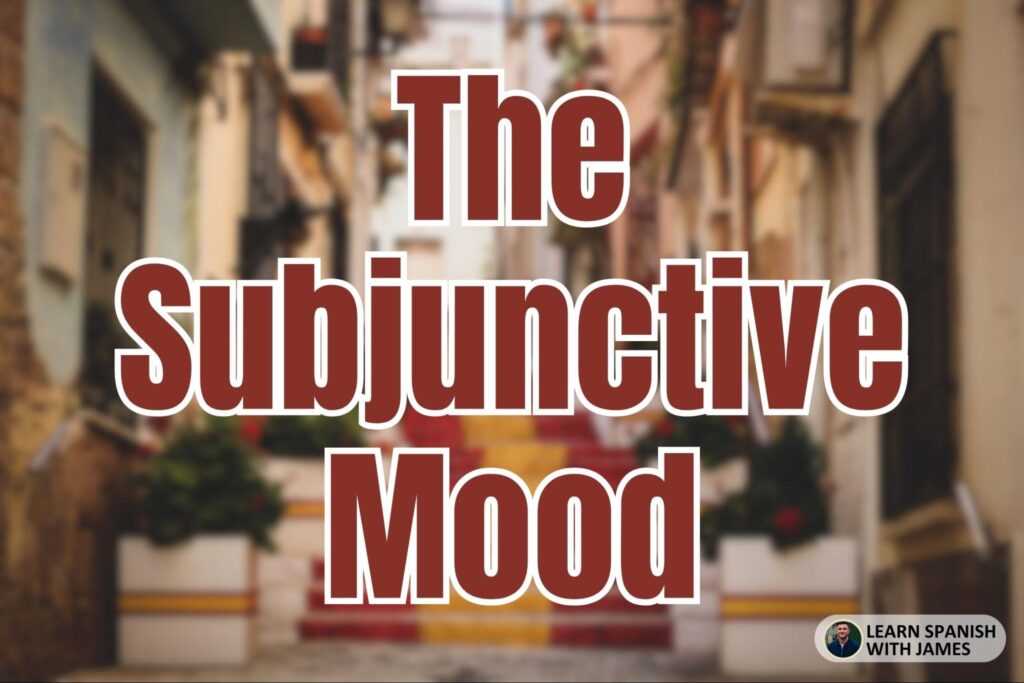All Spanish Verb Tenses: With Examples and Tips

Many Spanish learners find themselves struggling with verb tenses in Spanish. This guide aims to help you to learn all Spanish verb tenses in one place.
Whether you’re a beginner trying to get a grasp of the basics or an advanced learner refining your command of more complex Spanish tenses, my aim is to provide you with a clear guide on how to use Spanish verb tenses to express past, present, and future ideas fluently.
So, in this guide, I’ll show you when to use which tense and how to conjugate each verb group properly. I’ll also show you some example sentences for context.
I’m James, from Learn Spanish With James, and I’m so pleased you’re here to learn all about Spanish verb tenses.
Key Takeaways
- Spanish verb tenses are essential for fluency in Spanish. They allow speakers to discuss past, present, and future events with specific details.
- There are several tenses for each temporal frame, each with regular and irregular conjugations (depending on the verb), including moods like the indicative, subjunctive, and imperative for nuanced expressions.
- Mastering verb tenses isn’t just an academic exercise. You need to be able to conjugate verbs in Spanish if you want to engage in meaningful conversations, recount experiences, and express desires and possibilities.
- You can find hundreds of Spanish verbs with full conjugation charts for each of them in the Learn Spanish With James blog.
All Spanish Verb Tenses: A Comprehensive Breakdown

Picture this: you’re in a bustling Spanish mercado, haggling with vendors, asking for directions, or simply chatting with locals.
The ability to shift effortlessly between Spanish tenses can transform these exchanges from disjointed interactions into fluid conversations.
In Spanish, as in any language, verb tenses allow us to express actions in the past, present, and future.
Some of the most common tenses in Spanish include:
- Present tense
- Preterite tense
- Imperfect tense
- Perfect tense
- Future tense
- Conditional tense
By mastering these tenses, you’ll be able to express yourself more accurately and confidently in Spanish.
These tenses enable us to articulate our relationship with events, as well as express certainties, doubts, and desires.
For this, we turn to the mood of a verb, and in Spanish, we have three: the indicative, the subjunctive, and the imperative.
Read on to find a detailed breakdown of all Spanish verb tenses, complete with examples and tips to help you master them.
Conjugating Regular AR Verbs in the Present Tense

Spanish verbs are split into three groups, depending on the two letters they end with in the infinitive form.
These are: -AR verbs, -ER verbs, and -IR verbs.
Regular -AR verbs are the most straightforward verbs to learn. By regular, I mean they follow a specific pattern of conjugations.
Conjugating regular -AR verbs is easy. Imagine you want to talk about speaking or dancing, ‘hablar’ and ‘bailar’ respectively, in the present tense.
You simply drop the -ar ending and add the appropriate endings:
- -o
- -as
- -a
- -amos
- -áis
- -an
For instance, ‘hablar’ in the first person singular becomes ‘hablo’ (I speak), and ‘bailar’ in the first person plural becomes ‘bailamos’ (we dance).
Mastering these basic conjugations sets a solid foundation for tackling more complex tenses.

Conjugating Regular ER & IR Verbs in the Present Tense
Venturing deeper into the realm of Spanish verbs, we encounter -ER and -IR regular verbs.
While I did separate these two above, their endings are the same in many verb tenses.
The strategy here is to remove the -er or -ir ending and attach the suitable endings:
- -o
- -es
- -e
- -emos/-imos
- -éis/-ís
- -en
Take, for instance, ‘comer’ (to eat).
This becomes ‘como’ (I eat). The concept is similar for -IR verbs like ‘vivir’ (to live), becoming ‘vivo’ (I live).
Familiarizing yourself with these conjugations opens up a whole world of expression in the present tense.
Common Irregular Verbs in the Present Tense

Of course, just when we thought we had it all figured out, along came irregular verbs to shake things up.
These rebels of the Spanish verb family don’t adhere to the regular conjugation rules.
Verbs like:
- ‘ser’ (to be)
- ‘estar’ (to be) – see a full list of estar conjugations.
- ‘ir’ (to go) – see a full list of ir conjugations.
- ‘tener’ (to have) – see a full list of tener conjugations.
In Spanish, subject pronouns like ”él / ella” or “ellos / ellas” each have their unique conjugation patterns.
Don’t fear! Familiarity comes with practice.
Before long, you’ll be weaving these irregular verbs into your Spanish conversations with ease.
The Present Tense Subjunctive

Now, we’ll discuss the subjunctive, used depending on possibilities and hypothetical situations.
The present subjunctive in Spanish is a little tricky, but it’s a necessity, and used frequently.
You create the present subjunctive form by taking the first person singular of the present simple, drop the ending -o, and add -er and -ir tense endings.
For instance, ‘hablar’ becomes ‘hable’ (I speak).
For a full list of present subjunctive endings for -AR verbs, check out the present subjunctive section of this post on dejar conjugations.
The Past Tense in Spanish

Having discussed the present tense, it’s time to go through past tenses in Spanish.
Past tenses allow us to recount stories, share experiences, and reflect on past events.
The Spanish language offers a variety of ways to express actions in the past, each with its unique perspective.
Spansih past tenses include:
- Preterite tense (which focuses on completed actions)
- Imperfect tense (to express ongoing or recurring past actions)
- Perfect tense (we form this using the auxiliary verb ‘haber’)
- Pluperfect tense (used to express actions that had already occurred before another past action or point in time)
- Imperfect subjunctive (a past tense subjunctive form)
A lot to take in, right? Check out this list of all past tenses and their conjugations in this complete guide to poner conjugations.
The Preterite Tense

The preterite tense in Spanish is the storyteller’s tense.
It’s all about actions completed in the past. To form the preterite of any regular -ar, -er, or -ir verb, you simply remove the infinitive ending and add the preterite endings.
For instance, ‘hablar’ becomes ‘hablé’ (I spoke), ‘comer’ becomes ‘comí’ (I ate), and ‘vivir’ changes to ‘viví’ (I lived).
Using the preterite tense, you can recount past events, narrate stories, or talk about completed actions.
The Perfect Tense

We use the perfect for talking about recent events or actions that have some connection to the present.
This tense is built using the verb ‘haber’ in its present tense form, followed by a past participle.
For example, ‘he hablado’ (I have spoken).
This tense creates a bridge between the past and the present, allowing you to talk about past events that are still relevant now.
Using the Verb ‘Haber’ in the Perfect Tense

The auxiliary verb ‘haber’ holds a crucial role in forming perfect tenses in Spanish.
In the perfect tense, ‘haber’ is conjugated as:
- he
- has
- ha
- hemos
- habéis
- han
This is then combined with the past participle of the main verb to express completed actions.
Mastering ‘haber’ to its entirety will allow you to form multiple tenses.
The Imperfect Tense

The imperfect tense in Spanish is all about setting the scene, a mood, or describing ongoing, incomplete actions in the past.
Whether you’re talking about your childhood, describing a past state, or setting the scene in a story, the imperfect tense is your friend.
For example, ‘cuando era niño, quería ser futbolista.’ (When I was a kid, I wanted to be a footballer).
You can see how to use the imperfect tense using the verb ‘querer’ in this querer conjugation guide.
The Pluperfect Tense

The pluperfect tense in Spanish is used when you need to express an action in the past that happened before another past action.
This tense is formed by using the imperfect tense of the verb ‘haber’ followed by the past participle of the main verb.
For instance, ‘había comido’ (I had eaten).
This tense is a powerful tool for creating complex narratives about past events.
You can find plenty of examples about how to use the pluperfect tense in Spanish by looking at the pluperfect tense section of this volver conjugation chart.
The Imperfect Subjunctive Tense

The imperfect subjunctive in Spanish is a versatile tense used to talk about hypothetical situations, express wishes, doubts, and discuss unreal situations.
It’s formed by taking the third person plural of the preterite, dropping the ‘on’, and adding the endings:
- -ra
- -ras
- -ra
- -ramos
- -rais
- -ran
For instance, ‘hablar’ becomes ‘hablara’ or ‘hablase’ in the first person singular.
This tense is perfect for expressing hypothetical scenarios or expressing politeness.
I have put together a list of example sentences of the imperfect subjunctive in use in this seguir conjugation chart article.
The Future Tense in Spanish

We’ve covered the present and past tenses. Now, let’s look at the future tense.
The future tenses in Spanish include:
- The simple future tense (used to talk about what will happen)
- The conditional tense (used to talk about what would happen under certain conditions)
- The future perfect tense (used to talk about what will have happened)
I have put together a list of example sentences of each of these tenses, with conjugation tables, in this article about all parecer conjugations.
Note also that the future subjunctive, while not commonly used in modern Spanish, still holds a place in legal documents and some expressions.
The Simple Future Tense

The simple future tense in Spanish is your go-to for making predictions, promises, or plans in the future.
It’s simple to form – all you need to do is take the infinitive form of the verb and add the future endings.
These include:
- é
- ás
- á
- emos
- éis
- an
For example, ‘hablar’ becomes ‘hablaré’ (I will speak).
This tense is essential for talking about future events and actions.
The Conditional Tense

The conditional tense in Spanish helps us express what would happen under certain conditions.
It’s formed by taking the infinitive form of the verb and adding the conditional endings.
For instance, ‘deber’ becomes ‘debería’ (I would speak).
Here, you can find a full list of all deber conjugations and example sentences, including the conditional tense.
The conditional tense is perfect for expressing hypothetical situations or polite requests, and is often used with the imperfect subjunctive.
The Future Perfect Tense

The future perfect tense in Spanish allows us to talk about what will have happened by a certain time in the future.
This tense is formed by using the simple future of the verb ‘haber’ followed by a past participle.
Let’s look at this in use with the Spanish verb ‘llamar‘.
For instance:
- ‘habré llamado’ (I will have called)
- ‘habrás llamado’ (You will have called)
- ‘habrá llamado’ (He/she/it will have called)
- ‘habremos llamado’ (We will have called)
- ‘habrán llamado’ (They will have called)
This tense is great for expressing confidence about future actions.
The Subjunctive Mood: Conveying Possibilities and Desires

The subjunctive is based on possibilities, wishes, and hypotheticals.
In Spanish, we use the subjunctive mood to express our dreams, doubts, and desires.
It helps us convey not just what is, but what could be, should be, or we wish would be.
You can see how the subjunctive is used in context within this guide to the ‘poner conjugation’.
Whether we’re expressing desires with the present subjunctive, speculating about the future with the future subjunctive, or talking about hypothetical situations with the imperfect subjunctive, the subjunctive mood allows us to express a whole range of emotions, opinions, and possibilities that the indicative just can’t capture.
Wishes with Present Subjunctive
The present subjunctive is commonly used to express wishes. Whether you’re making a wish for yourself or someone else, the present subjunctive is the perfect tool to express these desires.
For instance, ‘Espero que tú vengas’ (I hope you come).
This usage of the subjunctive allows us to express our desires and hopes in a way that the indicative mood can’t.
Use Cases: The Imperfect Subjunctive
The imperfect subjunctive is a versatile and powerful tense that allows us to talk about hypothetical situations, express wishes, and speculate about the past.
Here is a use cases of the imperfect subjunctive.
- ‘If I were rich, I would travel the world’ (‘Si yo fuera rico, viajaría por el mundo’)
Moods in Spanish & What They Mean

Having explored the multitude of Spanish tenses, it’s time to understand the concept of ‘mood’ in Spanish.
The mood of a verb indicates the speaker’s attitude towards the action. Spanish has three moods: the indicative, the subjunctive, and the imperative.
The indicative mood is used to express facts, realities, and certainties. It’s the most commonly used mood and includes most of the tenses we’ve covered so far.
The subjunctive mood, on the other hand, is used to express various states of unreality such as doubt, possibility, necessity, or action that have not yet occurred.
The imperative mood is often used to give orders, such as “clean your room,” or to express requests, like “please pass the salt.”.
Understanding these moods and their uses is crucial to mastering Spanish, as they add depth to our communication and allow us to express a wide range of emotions, opinions, and attitudes.
The Indicative with Examples
The indicative mood is all about stating facts and describing reality. It’s the go-to mood for sharing information, making statements, and asking questions.
For instance:
- ‘Yo hablo español’ (I speak Spanish)
- ‘¿Dónde está el baño?’ (Where is the bathroom?).
This is use of the verb ‘estar’ – if you want to see a list of differences between ser vs estar, you can do so on this site.
The Subjunctive with Examples
The subjunctive mood is used depending on uncertainty, doubt, and subjectivity.
It’s used to express what could be, rather than what is. For instance:
- ‘Es posible que llueva’ (It might rain)
- ‘Dudo que él tenga razón’ (I doubt he is right).
The present subjunctive tense allows us to express our hopes, fears, doubts, and uncertainties.
The Imperative with Examples
The imperative mood is all about commands and requests.
It’s used to tell someone to do something or to ask someone not to do something.
For instance:
- ‘Habla más despacio’ (Speak slower)
- ‘No corras en la casa’ (Don’t run in the house).
You can find more information about how to use the imperative and negative imperative in Spanish here.
The imperative mood is central to giving instructions and making requests in Spanish.
Practical Applications: Verb Tenses in Action

Mastering these verb tenses extends beyond academic exercise. These tenses are the tools that bring our conversations to life, allowing us to:
- Share our experiences
- Tell stories
- Express our hopes and dreams
- Speculate about the future
- And so much more
Whether you’re ordering food at a restaurant, discussing a book you’ve read, talking about your childhood, or making plans for the future, these verb tenses are your keys to engaging and effective communication.
Interactive Learning: Engage with Spanish Tenses

Learning Spanish verb tenses need not be a chore. With interactive learning techniques, you can engage with Spanish tenses in a way that’s both fun and effective. Here are some suggestions:
- Try out language exchange apps
- Play online games
- Dive into Spanish music and films
- Use online platforms that offer interactive exercises and quizzes to practice verb conjugations
The secret lies in regular practice, in a manner that’s enjoyable and meaningful to you.
Remember, language learning is a journey, not a destination!
Frequently Asked Questions
In this section, you will find the most frequently asked questions relating to Spanish verb conjugations and tenses.
How many verb tenses are there in Spanish?
In total, there are 18 verb tenses in Spanish, including simple and compound tenses, such as Present, Imperfect, Preterite, Future, Conditional, and Subjunctive. These tenses are used for various circumstances and levels of formality in Spanish.
What are the 14 conjugations of Spanish?
In total, there are 14 conjugations in Spanish, which include Present, Imperfect, Preterite, Future, Conditional, as well as different Perfect and Subjunctive forms.
What are the 12 major verb tenses?
There are 12 main verb tenses: Simple Present, Present Continuous, Present Perfect, Present Perfect Continuous, Past Simple, Past Continuous, Past Perfect, Past Perfect Continuous, Future Simple, Future Continuous, Future Perfect, and Future Perfect Continuous.
Can you give an example of the preterite tense?
Sure, an example of the preterite tense is “Comí paella,” which means “I ate paella.”
Online Spanish Courses & Grammar Courses
Spanish verb tenses can be tricky. But with the right resources, language learning and being able to speak Spanish correctly and with confidence becomes easily.
For a full list of Beginner, Intermediate and Advanced Courses, check out this full list of online Spanish courses.
I put this list together myself, and it comprises a mixture of courses that offer Spanish grammar practice for all levels, conversational practice, listening and writing exercises in Spanish, free Spanish courses, and a whole lot more.
The fastest way to learn Spanish and its irregular verbs is to test a mixture of Spanish resources and choose the course that coincides most with your learning style.
In addition to online Spanish courses, on this site you will find a wide range of Spanish podcasts, Spanish apps, Spanish YouTube channels, and both online and physical Spanish language schools.

About James – Or Should that be Santiago?
My name is James. I am a Brit with a love for the Spanish language. I have lived in Spain, Argentina, and Costa Rica, and I have been teaching Spanish for over a decade. This site will show you how to master the elements of Spanish grammar that often dishearten learners. I hope you enjoy the site and find it useful.
If you are interested in taking your Spanish to the next level, check out the Courses section for a full list of the Spanish courses I suggest. All reviews are based on my personal opinions.





